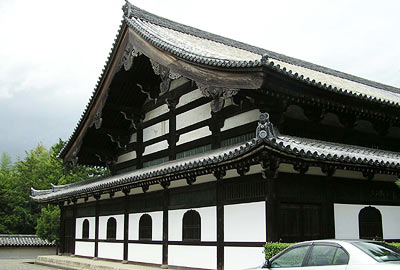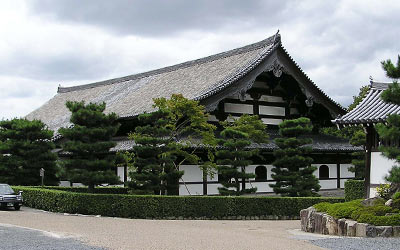|
||
 |
||


Toufukuji Zendou T° (Kyouto)
@
(C)2001 Japanese Architecture and Art Net Users System.@No reproduction or republication without written permission.
fÚÌeLXgEÊ^ECXgÈÇASÄÌRec̳f¡»E]ÚðֶܷB
|
||||||
| @ | ||||||
| zendou@T° | ||||||
| KEY WORD :@architecture / buildings & structures | ||||||
| @ | ||||||
| Also called *soudou m°; sometimes *masodou _·° at Oubaku ©@ sect, temples. Other names are saisoudou ¹m°, undou _°, and senbutsudou I§°. A meditation hall that is divided into two parts, the inner and outer, and has an earthen floor. One of the main buildings within the precincts of a Zen T temple. It is also where Zen monks received strict training, part of which was the practice of a meditation technique zazen ¿T. The best example of Zendou and the only one designated as a important cultural property is at Toufukuji (1415) in Kyoto. It is a large, single-storied building. The main core *moya ê®, is 7 ~4 bay (*ken Ô) and is surrounded by a one-bay deep enclosure with a pent roof *mokoshi ÖK. Altogether the outer measurements are 42.08m long ~ 21.92m deep. The entrance vestibule is a later addition. The pillars of the mokoshi are smaller in diameter than the main ones that surround the moya. Six large pillars are erected through the center of the moya which has a gabled roof *kirizuma-zukuri ØÈ¢, and has double rainbow beams and bottle struts nijuukouryou taiheizuka ñdøÀår©, in the gable pediments. Built primarily in the Zen style *zenshuuyou T@l, there is a flavor of the daibutsu style *daibutsuyou å§l, in the use of brackets arms *sashihijiki }IØ, inserted directly into the pillars on either side of the wide bay in the middle of the center line of pillars. The floor of the moya is paved with tiles set diagonally. The ceiling is boarded. Around the perimeter are low platforms zashou ¿à¬, on which the monks sat. Below the upper edge of the mokoshi roof are low openings fitted with vertical lath, between the moya pillars at each end, and two bays from the corner pillars at the back and the front at each end. The lath allows light and air into the central core of the building. The windows in the mokoshi are the zen style ogee type and are called *katoumado Î. Just above these openings are low openings with vertical lath surrounding the entire mokoshi. Another example as Manpukuji Zendou äÝT° (1663) in Kyoto. | ||||||
| @ | ||||||
  Toufukuji Zendou T° (Kyouto)
|
||||||
@ |
||||||
| REFERENCES: | ||||||
| @ | ||||||
| EXTERNAL LINKS: | ||||||
| @@ | ||||||
| NOTES: | ||||||
| @ | ||||||
(C)2001 Japanese Architecture and Art Net Users System.@No reproduction or republication without written permission. fÚÌeLXgEÊ^ECXgÈÇASÄÌRec̳f¡»E]ÚðֶܷB |
||||||
| @ |